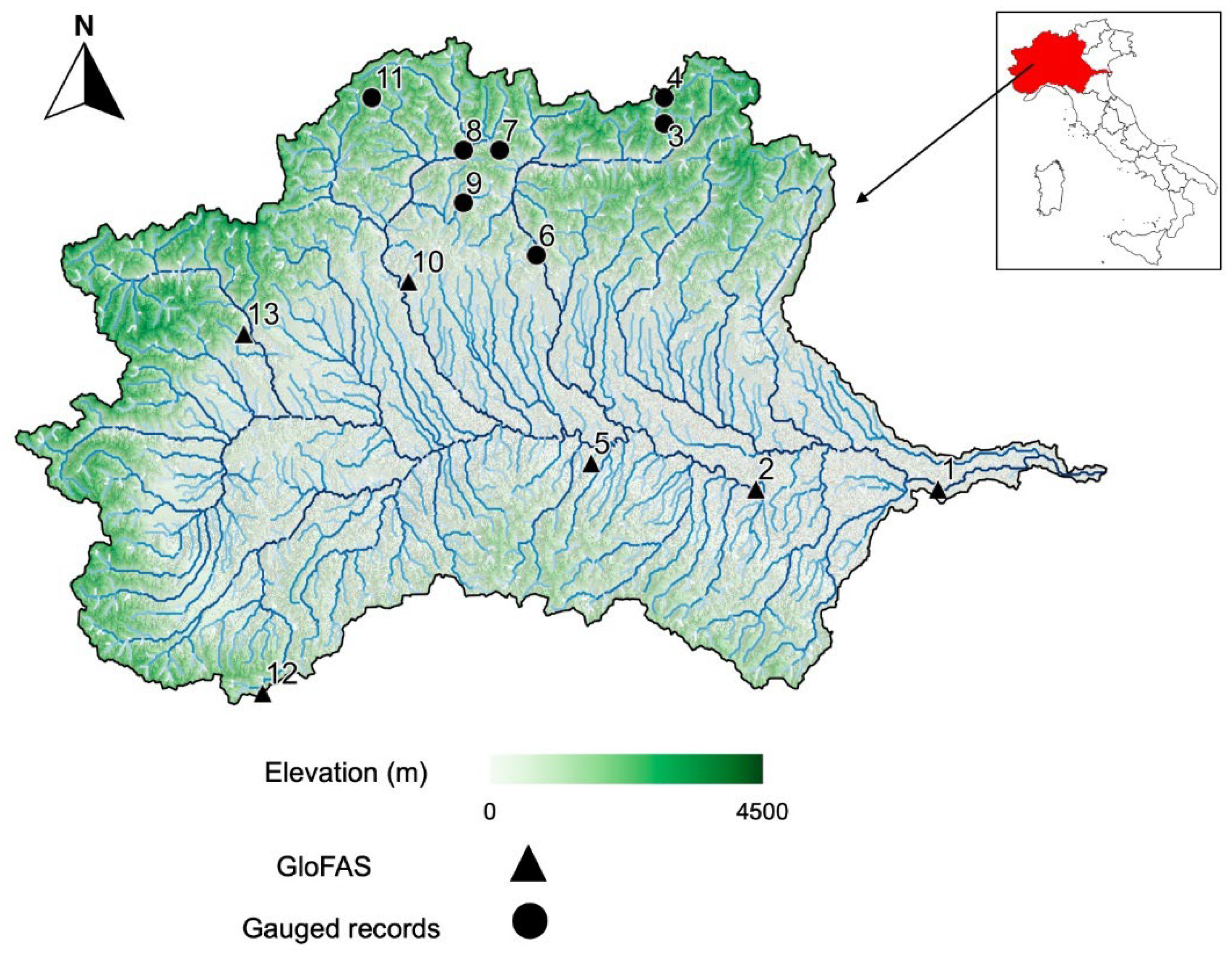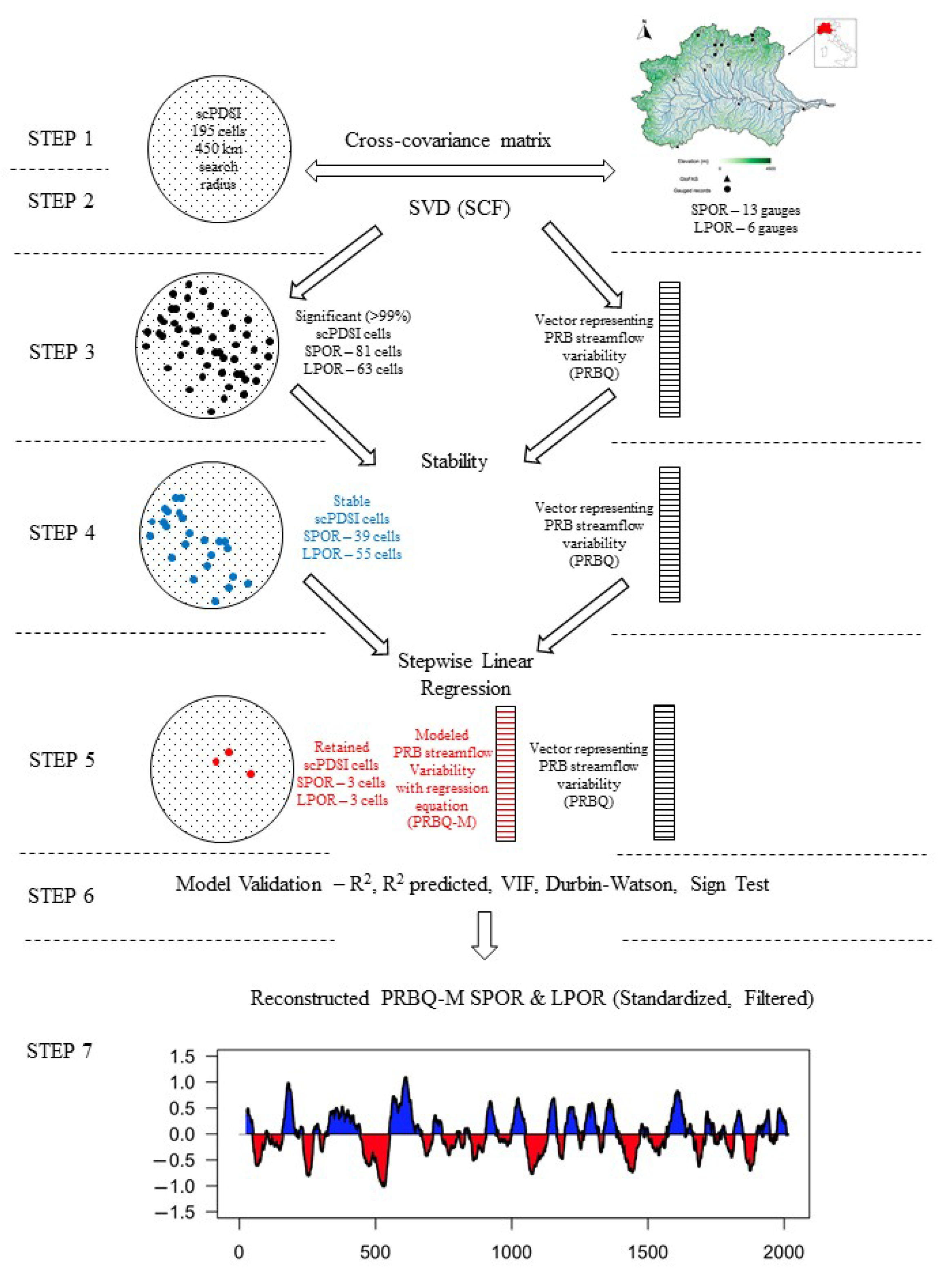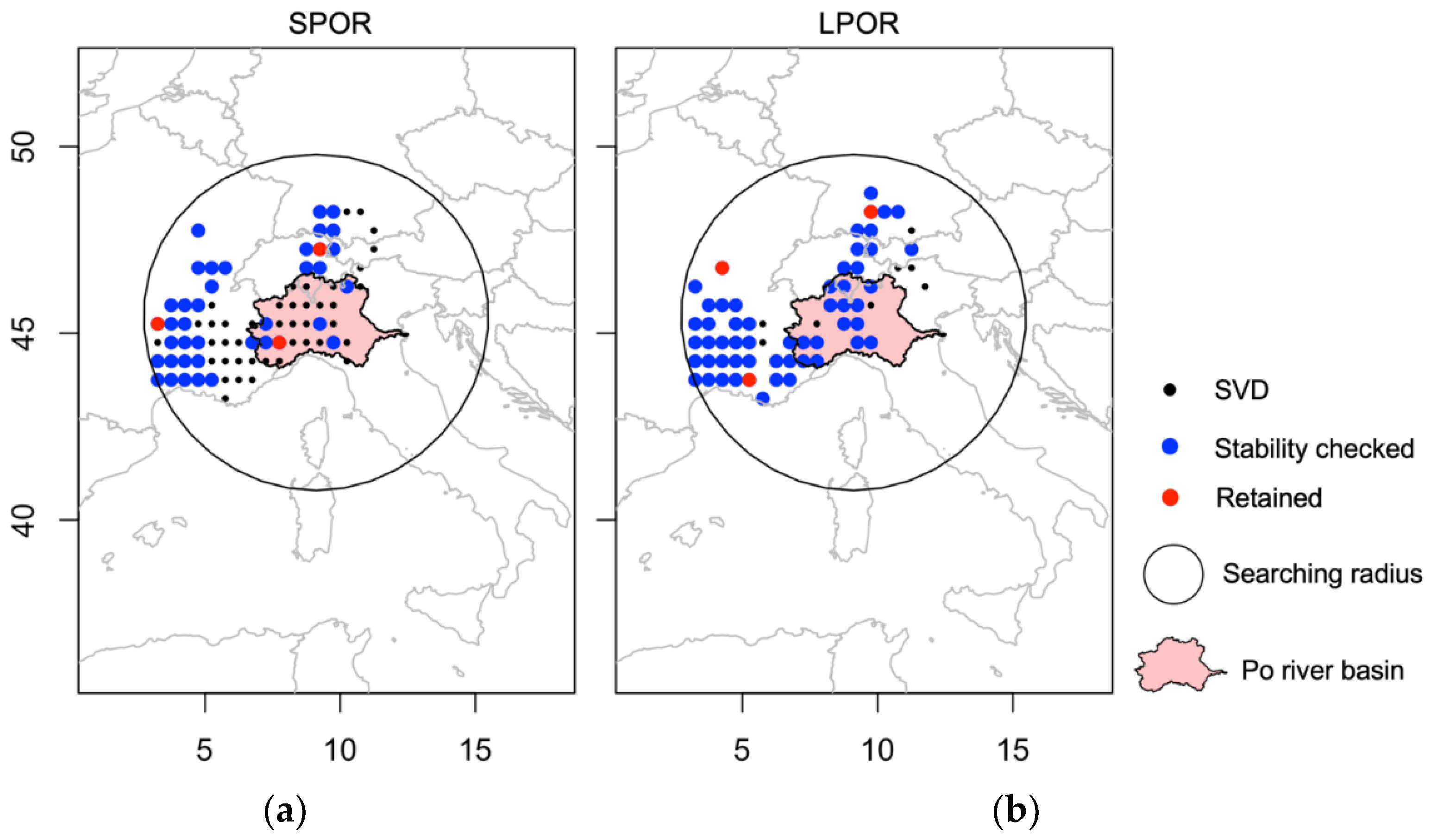1. Introduction
The Po River Basin (PRB) (
Figure 1), located in northern Italy between the Alpine and Apennine mountain chains, is the largest watershed in Italy, covering ~74,700 km
2 (~71,000 km
2 in Italy and ~3000 km
2 in Switzerland and France). The mean annual temperature varies between 5 and 15 degrees Celsius, being closer to 5 degrees Celsius in the Alpine region and to 10–15 degrees Celsius in the Apennine region [
1]. The mean annual precipitation is about 1200 mm, and the annual average discharge (during the period from 1923 to 2006) was 1500 m
3/s, with a maximum recorded peak flow of 10,300 m
3/s at Pontelagoscuro (close to the city of Ferrara) in 1951. The hydrological system of the PRB [
2] is highly complex and includes a variety hydroclimatic regimes: (1) the Alpine reaches, which are snow-dominated and fed by snow and glacial melt, presenting a typical seasonal peak flow between spring and early summer; (2) the Apennine rivers, which are dominated by rainfall, showing a minimum seasonal flow during the summer; and (3) the deltaic system of the Po River [
3], which is one of the most important in the Mediterranean Sea, covers an area of ~700 km
2, and is part of the UNESCO Man and Biosphere (MAB) Program. The interactions of this variety of hydroclimatic regimes together with the groundwater flow determine the annual regime of the Po River, which results in two hydrometric low-level periods (winter and summer) and two periods of flooding (late fall and spring).
The Po River basin is one of the most intensively populated, cultivated and highly developed areas of Europe. It hosts a total population of ~20 million people (the demographic density is ~225 inhabitants per km
2), and 35% of the valued-added economic production in Italy is located within the PRB [
4], including agriculture, manufacturing, and service providers. Water resource quantification and management is therefore crucial in such a watershed, given the high population density, intense agricultural land use, and hydro/thermal power plants (the majority are located in the upper PRB), where concurrent water uses have to be satisfied [
4,
5]. Specifically: (1) the agricultural production of the PRB represents 35% of the total national production [
2] and (2) the basin contains 890 hydropower plants, which produce 46% of the total Italian hydropower production, and 400 thermal power plants, which produce 32% of the total Italian power production [
2].
Given the importance of the PRB to its residents and the Italian economy, the ability to provide PRB water managers and planners information about PRB streamflow variability for increased timescales (paleo records) would be incredibly beneficial. Streamflow reconstructions using paleo proxies are limited in this region, with the most recent work [
6] focusing on the Rhine River Basin (RRB) and the PRB. Obertelli (2020) [
6] observed mixed results in obtaining good reconstruction skill in the RRB and poor reconstruction skill in the PRB. He attributed the poor PRB reconstruction skill to the influences of Alpine runoff [
6]. Thus, the motivation of the current research was to attempt to improve reconstruction skill in the PRB by (1) using an increased search radius for the consideration of proxies to use in reconstruction models; (2) utilizing singular value decomposition (SVD) as a data reduction tool and to generate a single vector to represent PRB streamflow variability, thus developing a regional (not gauge-based) PRB streamflow reconstruction; (3) developing regional PRB streamflow reconstructions for two periods of record for the comparison and evaluation of their influence on the results; and (4) applying and evaluating a rigorous group of statistics to alleviate concerns of model multicollinearity and over-fitting.
While traditional reconstructions of streamflow rely on tree-ring proxies, [
7,
8] developed a novel approach at both the basin scale (i.e., Missouri River Basin, U.S.) and the continental scale (i.e., Continental U.S. or CONUS), in which tree-ring-based reconstructions of the summer Palmer Drought Severity Index (PDSI) were used as reconstruction proxies. The PDSI data were obtained from the Living Blended Drought Atlas (LBDA) [
9], an updated version of the North American Drought Atlas [
10], and the LBDA has a spatial resolution of 0.5 degrees by 0.5 degrees across the CONUS. In [
7], the authors selected a search radius of 450 km from the streamflow gauge of interest and considered all LBDA PDSI cells within this radius when developing reconstruction models. In Europe, the Old World Drought Atlas (OWDA) provides annual June–July–August (JJA) self-calibrating Palmer Drought Severity Index (scPDSI) values for 5414 grid points across Europe from 0 to 2012 AD [
11]. Similar to [
6], the current research utilized the OWDA scPDSI as reconstruction proxies. While [
6] limited the consideration of OWDA scPDSI cells to (only) those within the PRB watershed, the current research considered OWDA scPDSI cells within a 450 km search radius of the centroid of the PRB, per [
7].
Perhaps the biggest challenge [
7] identified when utilizing the LBDA as a reconstruction proxy was the high spatial correlation of the LBDA grid cells, which could lead to multicollinearity challenges in reconstruction model development. Various statistical techniques exist to determine the relationship between two spatial-temporal fields, including regularized canonical correlation analysis (rCCA), as selected by [
7], and principal component analysis (PCA), as selected by [
6], which are both very appropriate. Singular value decomposition (SVD) has the advantage of being able to evaluate the cross-covariance matrix of two spatial-temporal fields to identify similarities between them, while PCA evaluates only one spatial-temporal field. In [
12], the authors concluded that singular value decomposition (SVD) was simple to use and preferable for general use, while [
13] found that SVD was a powerful technique that isolates the most important modes of variability, and multiple studies have applied SVD in the field of hydrology [
14]. SVD accomplishes two roles in that it serves as a data reduction tool for identifying significant spatial cells (i.e., independent variables—scPDSI) for use in the regression-based reconstruction models and generates a single time-series vector that represents the variability of streamflow for the multiple gauges identified in the PRB (i.e., the dependent variable). Ho et al. (2016) [
7] noted that, “A single reconstruction model would be advantageous in its ability to consider all streamflow stations at once rather than fitting 55 individual models.” Thus, the novel use of SVD addresses a desire of [
7] to generate a regional reconstruction instead of individual gauge reconstructions. The SVD-generated single time-series vector, which represents regional (multigauge) PRB streamflow variability, was utilized as the dependent variable in the regression-based reconstruction model, while the scPDSI cells identified by SVD served as the independent variables. The regional reconstruction complements [
6], who developed PRB reconstructions at Global Flood Awareness System (GloFAS) points within the PRB for the 1979 to 2012 period. For the current research, two periods were selected for reconstruction model development: the short period of record (SPRO), similar to [
6], from 1980 to 2012 (33 years), which includes thirteen PRB streamflow gauges, and the long period of record (LPRO) from 1967 to 2012 (46 years), which includes six PRB streamflow gauges. A rigorous set of statistics evaluated the developed regression models to alleviate concerns of over-fitting and multicollinearity, per [
7].
2. Materials and Methods
Streamflow data consisting of the average annual flowrate (m
3/s) were identified for thirteen gauges within the PRB (
Figure 1 and
Table 1). For measured data, we used the Global Run-off Data Center (GRDC) (
http://www.bafg.de/GRDC/, accessed on 1 June 2022) discharge dataset. For each of the gauged stations, we also extracted modeled continuous streamflow data (1980 to 2012) from the Global Flood Awareness System (GloFAS) [
15] (
https://cds.climate.copernicus.eu/cdsapp#!/dataset/cems-glofas-historical?tab=overview, accessed on 1 June 2022). Seven of the thirteen gauges provided complete data for the period of record of 1980 to 2012. Data for six of the thirteen gauges were supplemented with GloFAS data if, for the overlapping period of the gauge and GloFAS annual streamflow, the Nash–Sutcliffe Efficiency (NSE) statistic exceeded 0.50 and the percentage bias (PBIAS) was between ±15 and ±25 [
16].
Table 1 identifies the gauges with complete records and gauges with supplemented GloFAS data. The streamflow data consisted of both impaired and unimpaired gauges to increase the spatial coverage within the PRB. The use of this streamflow data was justified based on intercorrelations between the thirteen gauges for the 1980 to 2012 period of record (33 years or short period of record—SPOR), exceeding 99% significance for 72 of 78 combinations, with the six outliers achieving significance levels ranging from 93% to 98%. A subset of six PRB gauges were identified with a period of record of 1967 to 2012 (46 years or long period of record—LPOR) (
Figure 1 and
Table 1).
The Old World Drought Atlas (OWDA) provides annual June–July–August (JJA) self-calibrating Palmer Drought Severity Index (scPDSI) values for 5414 grid points across Europe from 0 to 2012 AD [
11]. Similar to [
7], the current research utilized the OWDA scPDSI as a proxy for PRB streamflow reconstructions and included 195 scPDSI cells within a 450 km search radius of the centroid of the PRB.
SVD is a multivariate technique for identifying relationships between two spatial-temporal fields [
12]. In the field of hydrology, early applications of SVD included the evaluation of sea surface temperatures (SSTs) and precipitation [
17], and SSTs and drought [
18]. Two matrices (a matrix of standardized scPDSI anomalies and a matrix of standardized annual streamflow anomalies) were developed, in which the time dimension of each matrix (i.e., 33 years for the SPOR or 46 years for the LPOR) must be equal. The cross-covariance matrix was then computed (
Figure 2—STEP 1), and SVD was applied (
Figure 2—STEP 2), which resulted in two matrices of singular vectors and one matrix of singular values (1st mode, 2nd mode, etc.). The squared covariance fraction (SCF) is a useful measurement of the importance of modes [
12]. Each singular value was squared and divided by the sum of all squared singular values to produce a fraction (or percentage) of squared covariance for each mode. If the leading three (e.g., 1st, 2nd, and 3rd) modes explain a significant amount (i.e., >80%) of the variance in the two fields, then SVD can be utilized [
19] (
Figure 2—STEP 2). The two matrices of singular vectors were examined, generally referred to as the left (i.e., scPDSI) matrix and the right (i.e., streamflow) matrix. The first column of the left matrix (1st mode) was projected onto the standardized scPDSI anomalies matrix, and the first column of the right matrix (1st mode) was projected onto the standardized streamflow anomalies matrix. This resulted in the 1st temporal expansion series (TES) of the left and right fields, respectively, and they are referred to as the left 1st TES and the right 1st TES (hereafter referred to as PRBQ). Each TES vector has dimensions of one by the number of years (i.e., either 33 years or 46 years). The left heterogeneous correlation values (for the 1st mode) were determined by correlating the scPDSI values of the left matrix with PRBQ, and utilizing the approaches of [
17,
18], heterogeneous correlation figures displaying significant correlation values for scPDSI were developed (
Figure 2—STEP 3). While SVD is an incredibly effective statistical tool for data reduction and identifying significant scPDSI grid points, the PRBQ represents a single vector of annual streamflow variability, accounting for all gauges (either thirteen or six) in the PRB.
SVD identified significant scPDSI cells for both SPOR and LPOR, and cells of 99% significance or greater were considered for use in the reconstruction model. Prior to input into the reconstruction model, a final prescreening method was applied to investigate temporal stability, per [
20], which consisted of performing correlations over moving windows between the PRBQ and the retained scPDSI cells for both the SPOR and LPOR (
Figure 2—STEP 4). A thirty-year moving correlation window was selected by [
21,
22]. However, in [
22] the average streamflow record was ~77 years in length. Thus, the thirty-year moving correlation window was ~40% of the total period of record. The authors selected a conservative and more rigorous moving correlation window of approximately one third (~33%) for the SPOR (an 11-year moving correlation window) and the LPOR (a 15-year moving correlation window). A stability analysis ensured that reliable and practical streamflow reconstructions were generated.
A forward and backward stepwise linear regression (SLR), per [
21,
22,
23] (
Figure 2—STEP 5), was used to develop models for the reconstructions, and various statistics were used to test model skill (
Figure 2—STEP 6). R
2 (model variance), R
2 predicted (drop-one cross-validation) [
24], the variation inflation factor or VIF (1 to 10 reveals a low correlation between predictors and predictand) [
25], the Durbin–Watson (D–W) statistic, which tests for autocorrelation [
26], and the sign test, which counts the number of agreements and disagreements between observed and reconstructed (modeled) flow, were used for model validation. The modeled flow was standardized, and a 30-year end-year filter was applied (
Figure 2—STEP 7).
3. Results
SVD Model: The cumulative SCF for the first three modes was 98% for the SPOR and 99% for the LPOR, and generally, if the first three modes explain a significant (greater than 80%) amount of the variance between the two fields, then SVD can be applied to determine the strength of the coupled variability present [
19]. The 1st mode of SCF was 90% for the SPOR and 94% for the LPOR. Thus, only results for the first mode were provided.
scPDSI—For the 1st mode, scPDSI correlation maps for both the SPOR and LPOR were developed, and cells exceeding 99% significance (SPOR—81 cells and LPOR—63 cells) were identified (
Figure 3a,b).
Streamflow—For both the SPOR (thirteen gauges) and LPOR (six gauges), all gauges exceeded 99% significance. The PRBQ vectors, generated via SVD for use as regional reconstructions, were developed for both the SPOR and LPOR. For the SPOR, the PRBQ vector was correlated with each of the thirteen gauges, and the R
2 values are provided in
Table 1. This was repeated for the LPOR such that the PRBQ vector was correlated with each of the six gauges, and the R
2 values are provided in
Table 1. As displayed in
Table 1, the SVD-generated PRBQ vector, for both the SPOR (average R
2 = 71%) and the LPOR (average R
2 = 81%), captures a high degree of the variability of the individual streamflow gauges. Thus, the use of the PRBQ vector was appropriate as a regional representation of PRB streamflow variability for both the SPOR and LPOR.
Predictor Prescreening: For the SPOR, the 11-year moving-window correlation analysis of the 81 scPDSI cells and the PRBQ vector identified by SVD, 39 scPDSI cells were deemed stable and were considered for the SLR model (
Figure 3a). For the LPOR, the 15-year moving-window correlation analysis of the 63 scPDSI cells and the PRBQ vector identified by SVD, 55 scPDSI cells were deemed stable and were considered for the SLR model (
Figure 3b). It was notable that the majority of the stable cells were spatially located west and within the PRB, verifying the general climate (moisture) signal of a west-to-east movement.
Reconstruction Models: The reconstruction of the SPOR regional PRBQ annual streamflow vector resulted in exceptional statistical skill. The SLR model retained three scPDSI cells (#44, #111, and #140) (
Figure 3a). Model results of R
2 = 0.77; R
2 predicted = 0.69; VIF = 1.0; D-W = 1.71 (Pass); Sign Test 15+/18- (Pass) and a model equation of PRBQ − Modeled (SPOR) = 0.301 + 0.783 * scPDSI (44) + 0.477 * scPDSI (111) + 1.100 * scPDSI (140) were obtained. The reconstruction of the LPOR regional PRBQ annual streamflow vector again resulted in strong statistical skill. The SLR model retained three scPDSI cells (#14, #54, and #167) (
Figure 3b). Model results of R
2 = 0.65; R
2 predicted = 0.56; VIF = 1.0; D–W = 1.69 (Pass); Sign Test 22+/24- (Pass) and a model equation of PRBQ − Modeled (LPOR) = −0.020 + 0.355 * scPDSI (14) + 0.454 * scPDSI (54) + 0.795 * scPDSI (167) were obtained.
The SPOR and LROR models were standardized, and a 30-year end-year filter (moving average) was applied (
Figure 4). Referring to
Figure 4, each reconstruction generally captured similar drought and pluvial periods. The end of the 5th century to the beginning of the 6th century reveals a megadrought period peaking around ~530 AD, with the SPOR model showing a greater decline when compared to the LPOR model. Interestingly, the most robust pluvial period immediately followed this megadrought and peaked around ~610 AD.
The relative agreement (visual assessment of
Figure 4) between the two models (SPOR and LPOR) was encouraging, given (1) two different periods of record were evaluated and independent regression models were generated for each; (2) the gauges used for the SPOR reconstruction were spatially distributed across the entire PRB, while the gauges used for the LPOR reconstruction were generally more associated with Alpine streamflow; (3) each model (SPOR and LPOR) retained three scPDSI proxies, and for each model the retained scPDSI proxies (cells) differed; and (4) the reconstruction skills for both models were strong, and each model passed a rigorous assessment of multicollinearity and over-fitting.












